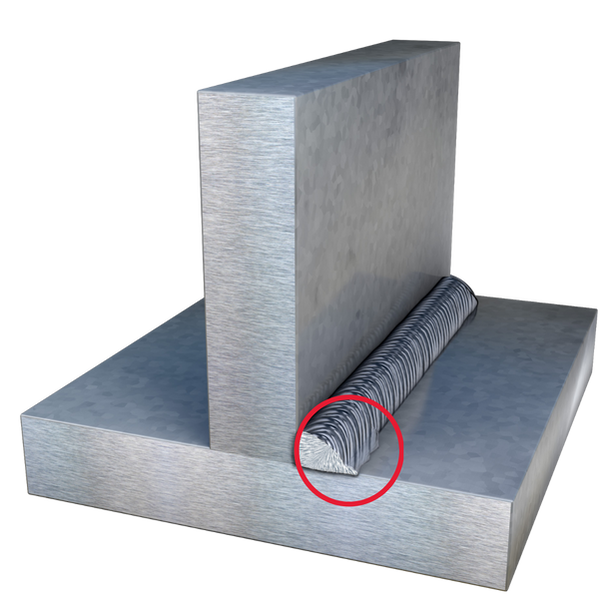Finest Practices for Preventing Weld Undercut: Mastering the Essentials
Wiki Article
Comprehending the Causes and Solutions for Undercut Welding in Metal Construction Processes
In the world of steel fabrication processes, the event of undercut welding poses a substantial challenge that demands a detailed understanding of its causes and practical services. The complex interplay of various elements during welding operations can bring about this unwanted phenomenon, influencing the structural stability and total top quality of the welded joints - Preventing weld undercut. By studying the origin triggers of undercut welding and discovering efficient restorative steps, makers can elevate the requirement of their handiwork and ensure the manufacturing of remarkable steel elementsCommon Sources Of Undercut Welding
Regularly ignored in metal construction, undercut welding takes place due to various aspects that demand precise attention and knowledge to be successfully minimized. In addition, incorrect welding methods, such as making use of the incorrect welding angle or take a trip speed, can additionally add to damage development. The selection of welding criteria, such as voltage, current, and cord feed speed, plays a considerable role in the incident of undercut welding.
Influence of Incorrect Welding Parameters
Imprecise welding parameters can considerably jeopardize the honesty and top quality of welded joints in steel fabrication procedures. The influence of incorrect welding parameters manifests in numerous means, causing architectural weak points and defects in the bonded components. One critical element affected by inappropriate welding specifications is the penetration depth of the weld. Inadequate heat input due to reduced welding currents or exceedingly high traveling speeds can cause insufficient fusion in between the base steels, bring about insufficient joint penetration and weakened bonds. On the other hand, extreme heat input brought on by high welding currents or slow travel speeds can lead to too much and burn-through support, creating a brittle and unpredictable weld framework. In addition, inaccurate parameters such as improper voltage settings or inaccurate electrode angles can contribute to unpredictable weld bead accounts, absence of combination, and raised opportunities of problems like undercutting. Precise focus to welding criteria is paramount to make sure the manufacturing of high-grade welds with the desired mechanical residential properties and architectural stability.Result of Improper Torch Angle
Improper lantern angle in welding operations can substantially affect the top quality and integrity of the last weld joints in metal manufacture procedures. Damaging is a common welding issue where a groove forms along the weld toe, deteriorating the joint and compromising its structural honesty.A torch angle that is too high can lead to inadequate infiltration, insufficient blend, and enhanced spatter. On the various other hand, a torch angle that is as well superficial can result in excessive penetration, burn-through, and distortion of the base material. Preventing weld undercut. Appropriate lantern angle is crucial for making sure constant weld top quality, stamina, and appearance
To avoid undercutting and various other flaws triggered by inappropriate lantern angles, welders have to be trained to maintain the appropriate torch angle throughout the welding process. Routine monitoring and adjustment of torch angles during welding can assist accomplish sound welds with marginal flaws.
Role of Inadequate Welding Strategies

One more facet of poor welding methods is incorrect weld preparation. Inadequate cleansing of the base steels, wrong joint style, or insufficient side prep work can all add to damage welding. Poor securing gas coverage or utilizing the wrong type of gas can result in incomplete blend and the development of undercut defects.
To resolve the role of poor welding strategies in steel manufacture processes, it is important to offer comprehensive training for welders. Proper education on welding parameters, joint prep work, and shielding gas selection can aid avoid undercut welding and ensure high-grade welds in steel manufacture projects.
Efficient Solutions for Undercut Welding
Dealing with undercut welding in metal construction calls for carrying out effective remedies to improve weld high quality and structural integrity. Among the main services to battle undercut is to change welding parameters such as voltage, present, and travel speed to ensure appropriate heat input and combination. By fine-tuning these setups, welders can stop too much melting of the base steel and filler material, lowering the probability of undercut development.In check this addition, proper joint preparation is important in stopping undercut. Ensuring tidy base steel surface areas devoid original site of pollutants and using the appropriate bevel angle can aid promote better weld infiltration and minimize the threat of undercut - Preventing weld undercut. Using ideal welding strategies, such as oscillating the lantern or weaving, can also aid in distributing warmth equally and loading the weld joint effectively, decreasing the opportunity of undercut problems
In addition, selecting the correct welding consumables, consisting of electrodes and filler steels, is necessary in reducing undercut. Utilizing products with ideal chemical make-ups and mechanical residential properties can add to achieving sound welds with marginal undercut. Normal evaluation and quality assurance steps ought to likewise be executed to discover and address undercut concerns quickly, making certain the general stability of produced metal components.

Conclusion
Finally, recognizing the reasons and solutions for undercut welding in metal fabrication processes is critical for achieving top quality welds. By addressing typical causes such as incorrect welding specifications, improper lantern angle, and poor welding techniques, welders can protect against undercutting and guarantee solid, durable welds. It is vital to pay focus to these elements and execute effective remedies to improve the overall welding procedure and end product top quality.
Report this wiki page